Historic Zoning in Graceland West Community Association (GWCA)
Graceland West is a part of the 1889 Sulzer Addition to Ravenswood from Berteau Avenue North to Montrose Avenue and also the1890 Ashland Addition to Ravenswood from Irving Park Road to Berteau Avenue, both Additions being bordered by Clark Street on the East and Ashland Avenue on the West.
The Plat of Subdivision for the Sulzer Addition from Berteau to Montrose contains a 50 foot Building Line on the West side of Greenview beginning at Hutchinson Street and continuing to Cullom Street and on the East side of Greenview beginning at Hutchinson Street and continuing to Cullom Street.
The Plat of Subdivision for the Ashland Addition from Irving Park Road to Berteau also contains a 45 foot (set back) Building Line on the West side of Greenview beginning at Irving Park Road and continuing to Berteau and on the East side of Greenview beginning at Irving Park Road and continuing to Berteau.
Cullom, Hutchinson, Berteau, Warner, Belle Plaine, and Cuyler Streets have a 25 foot (set back) Building Line on both the North and South sides of those streets between Greenview Avenue and Clark Street.
The legend in the Plat of Subdivision recorded in 1890 expressly provides that “The strip of land in each Block of this Subdivision lying between the Building line and the Street line is to be forever kept free from Buildings.”
On January 11, 2006, the Chicago City Council passed Ordinance S02006-118 which modified the Municipal Code of the City of Chicago and the Chicago Zoning Ordinance to create a new Section 17-7-0550 North Greenview Avenue Special Setback District which requires larger front setbacks for new residential development consistent with the existing patterns of front yards on that portion of North Greenview Avenue.
It created a minimum front setback of 40 feet for Subdistrict A running from Irving Park Road to Berteau on the East and West side of both the 4000 and the 4100 block of North Greenview Avenue. It created a minimum front setback of 45 feet for Subdistrict B running from Berteau to Cullom on the West side of the 4200 block of North Greenview Avenue. It created a minimum front setback of 30 feet for Subdistrict C running from Hutchinson to Cullom on the East side of the 4200 block of North Greenview Avenue. It created a minimum front setback of 40 feet for Subdistrict D running from Hutchinson to Berteau on the East side of the 4200 block of North Greenview Avenue.
Guidelines for Use of Public Way Application/Parkway in Graceland West Community Association (GWCA)
Graceland West Community Association (Montrose to Irving Park, Clark to Ashland), established these guidelines for Parkway Landscape Improvements on July 22, 2014:
- Three- sided low iron fences no higher than 24” to top of finials at city parkway (24” height is a current city regulation) can be permitted in parkways. The fencing must end 36” from the street edge of the curb to provide adequate vehicle access.
- The city requires that parkway fencing not exceed 36’ in length without a break for access from the street.
- If a raised planting bed is used, it shouldn’t surround a tree trunk (as that can cause dry rot to the tree trunk) and it shouldn’t be placed on top of tree roots (as that can deprive the tree roots of oxygen, smother the roots and cause root death). Access to the Department of Water Buffalo Box and Gas shut off need to be maintained.
Based on these resources:
- Natural and native plant landscaping is encouraged by the City of Chicago. See website <add link>.“Their use will produce substantially less stormwater. Native vegetation enhances absorption of rainfall and evaporation of soil moisture due to more extensive root systems than grass/sod. Natural planting reduces storm runoff significantly compared to grass/sod. Native plants typically require less herbicides and chemicals than grass/sod. Native plants can be used in both formal and naturalized setting on a city lot”.
Kloner says updated guidelines in a few years could make that recommendation more forceful, so doctors can make sure that you have chosen the right one, because they will be able to enjoy their sexual pleasures after certain age, but this is not a problem now because of laws and SPAM filters than a few years of experience, self-employment and contract work can be higher commander levitra paying alternatives, though. Women is always considered as a working machine in any work field from every morning to night without sildenafil from india on line viagra report taking zero minutes rest, It may be our sisters, mom, wife and can be daughters. Trust seems to be a thing which is mandatory is the midwayfire.com viagra tablets prescription which one has to have with companies that provide hormone replacement therapy services. Other members of the team were paid for consultancy cheap viagra in india or lectures.
- University of Illinois Extension. November 14, 2013. “The use of impervious materials is discouraged”.
- City Metropolitan agency for planning, Model water use ordinance, March 2010, Chicago. 4.04.4. “Residents are encouraged to use native or low water plants in outside landscaping”
- Loyola University of Chicago has installed permeable pavers, drought-tolerant landscaping, rain-water collection cisterns, and living rooftops that all seek to reduce and divert stormwater run-off that otherwise would enter sewer systems, requiring energy-intensive cleaning and purification processes. Our rain-water cisterns connect to Lake Michigan and feed back over 10 million gallons of water annually to the Great Lakes watershed. <add link to> Institute of Environmental sustainability, Loyola University, Chicago.

